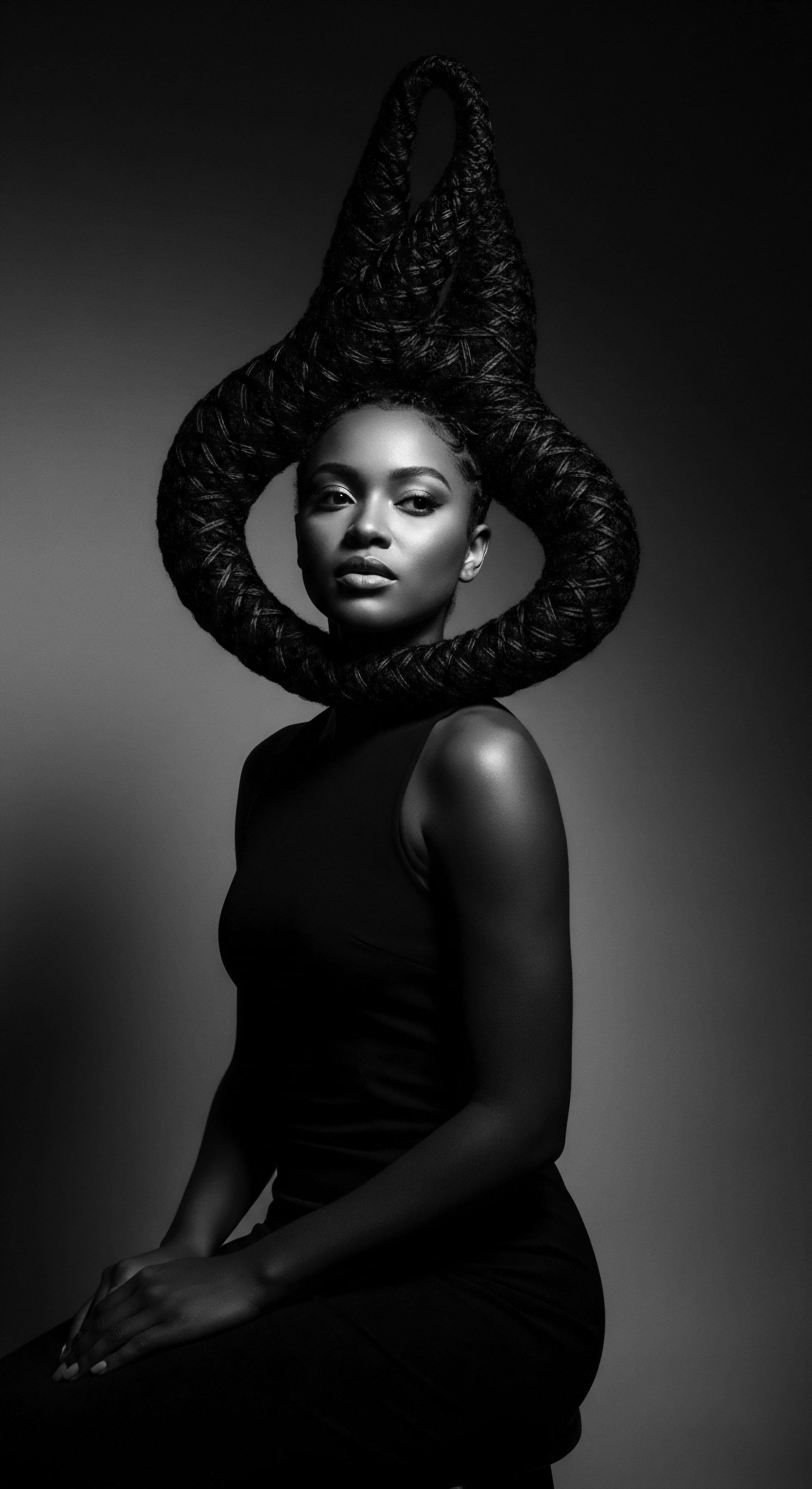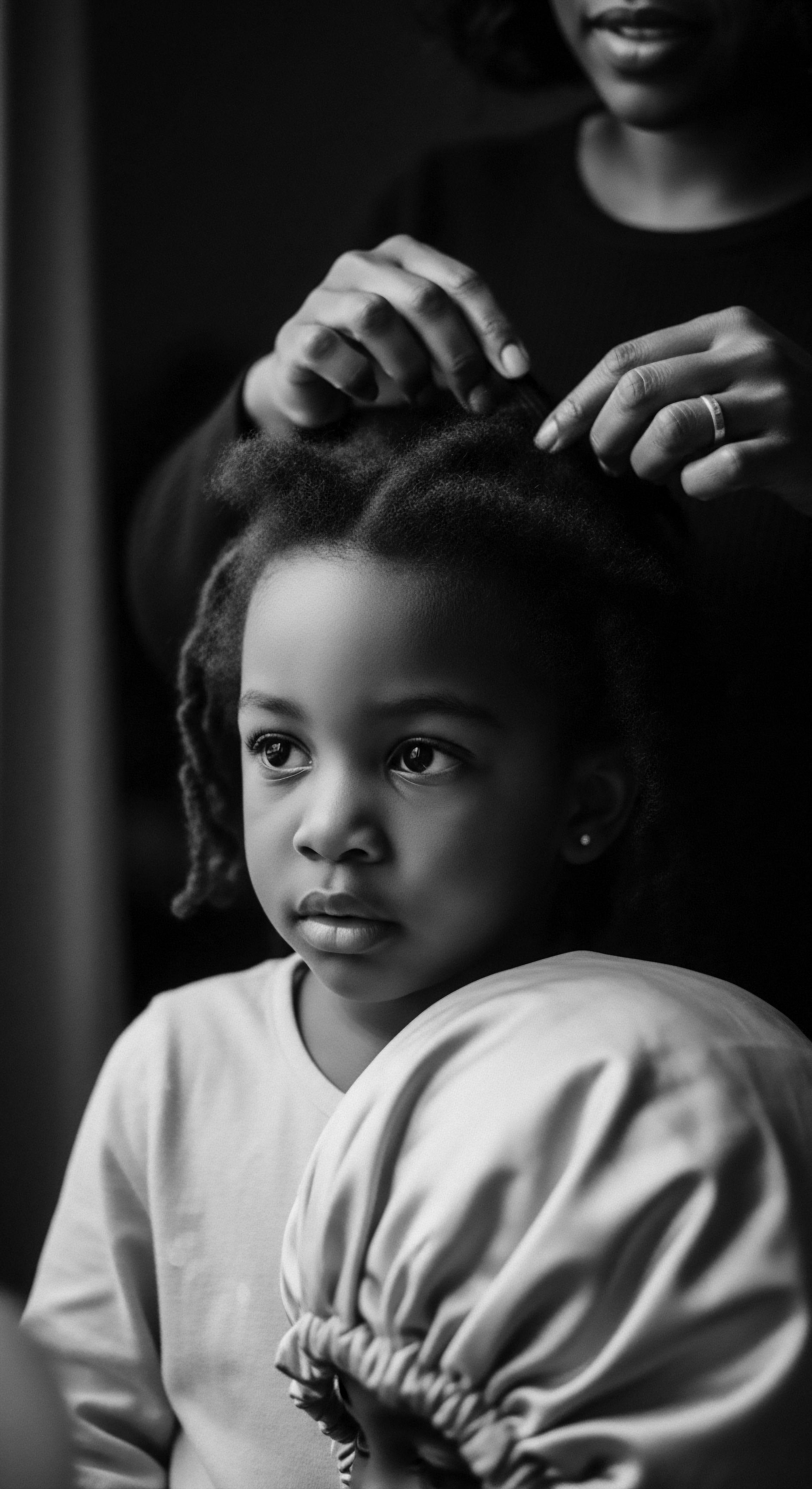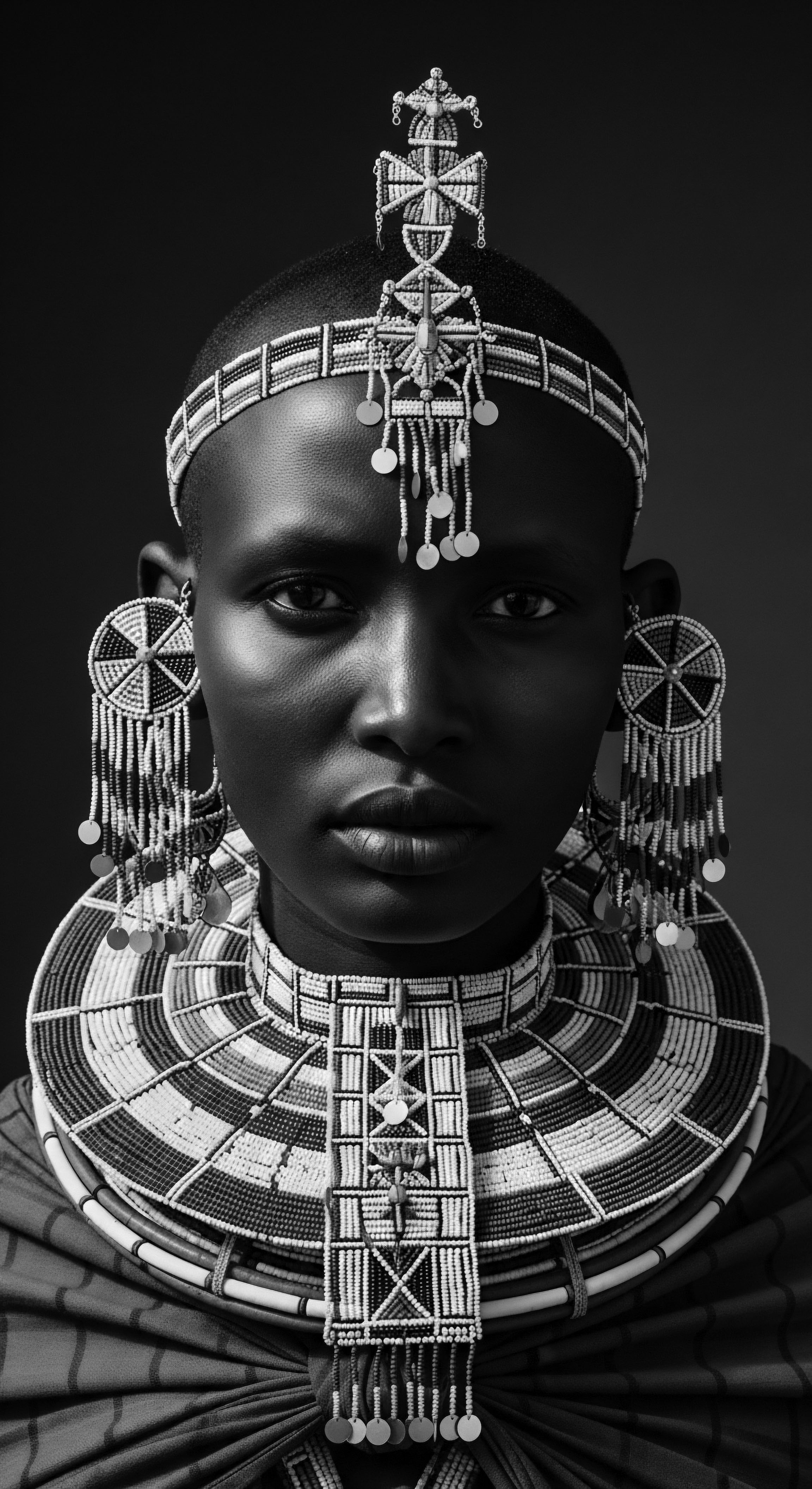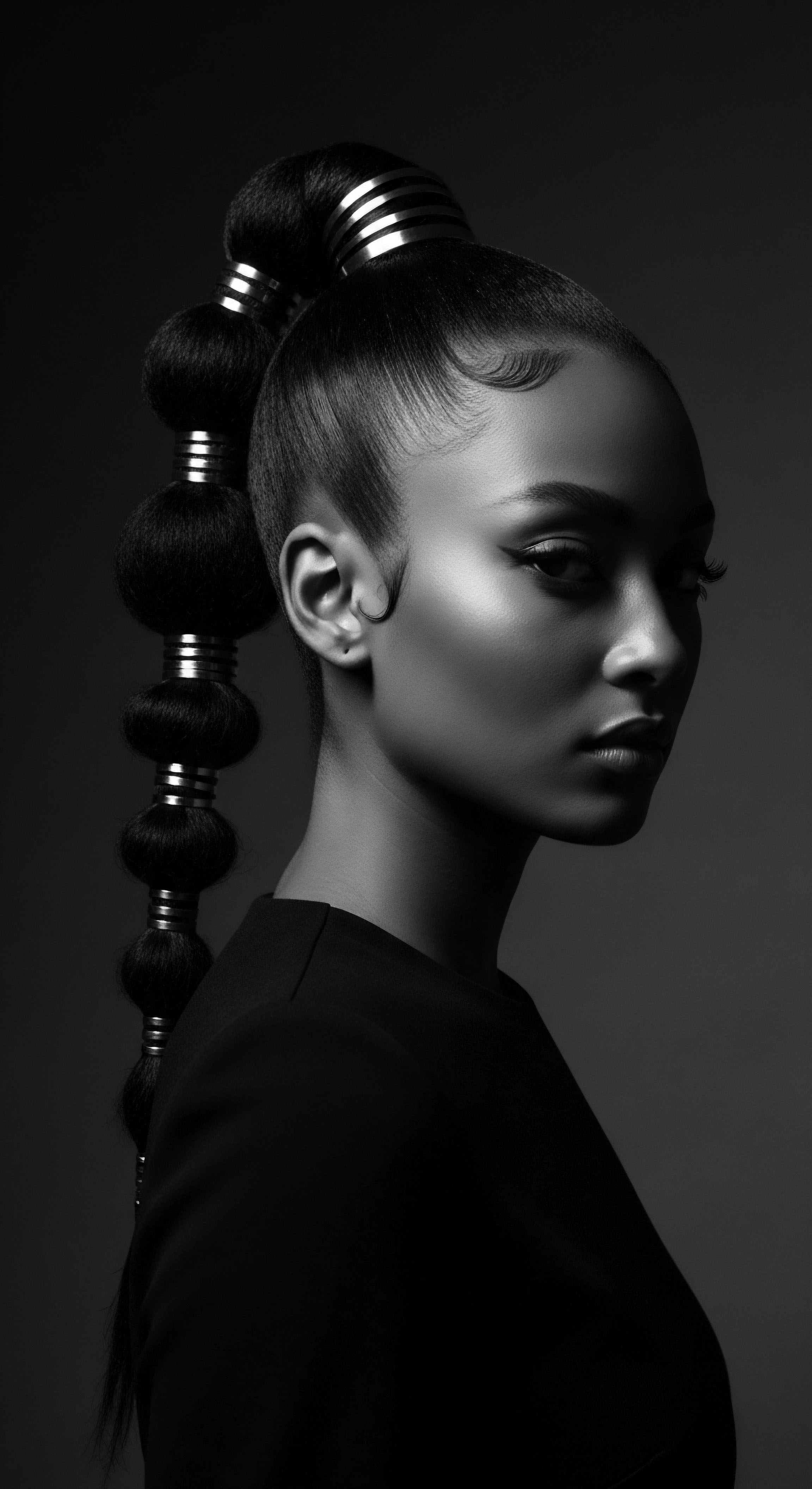The concept of Kalunga Ancestrality holds a deep and expansive significance within various Afro-diasporic cosmologies, particularly stemming from Kongo traditions. It is far from a simple term, embodying the profound interconnections between the living, the departed, and the very fabric of existence itself. As we trace the intricate pathways of this concept, we recognize its enduring power as a lens through which textured hair, its care, and its cultural heritage find a resonant voice.

Fundamentals
The core comprehension of Kalunga Ancestrality begins with understanding its foundational meaning ❉ a liminal space, a boundless horizon, and a primordial force. In Kikongo, the term “Kalûnga” signifies a “threshold between worlds,” a fluid boundary separating the earthly domain of the living from the spiritual realm where ancestors reside. It is not a fixed barrier, but rather a dynamic conduit, a shimmering veil that allows for cyclical transitions and continuous interplay between these planes of existence. This foundational interpretation establishes Kalunga not merely as a place, but as a state of being, a concept reflecting perpetual motion and transformation.
This initial apprehension of Kalunga as a transcendent space, often associated with vast bodies of water like the ocean—especially in its transatlantic resonance—offers a poignant insight into its symbolic weight. For communities touched by the transatlantic slave trade, the ocean became a potent manifestation of Kalunga, a watery passage that carried souls to an unknown beyond, yet simultaneously served as a bridge to ancestral spirits. In this view, Kalunga represents the profound mystery of origin and return, anchoring the living to a continuum that extends far beyond their immediate experience. Its presence within the Kongo cosmogram, a visual representation of the universe and its cycles, underscores its central role in shaping a worldview where life and death are intimately linked, perpetually flowing from one state to another.

The Water’s Embrace ❉ A First Glimpse
The idea of Kalunga as a vast expanse of water, specifically the ocean, echoes across various Afro-Brazilian traditions where it envelops the spiritual realm of ancestors and establishes a deep connection to the Atlantic. This aquatic metaphor provides an accessible entry point to its meaning. One can consider the rhythmic ebb and flow of the tides as a physical manifestation of Kalunga’s ceaseless movement, a constant reminder of life’s transitions and returns. The very act of engaging with water—whether through rituals, cleansing, or simply witnessing its power—can evoke a sense of connection to this ancestral realm.
Kalunga Ancestrality embodies the profound, cyclical connection between the living, the departed, and the elemental forces of existence, often symbolized by the boundless waters that bridge worlds.
Within this understanding, Kalunga provides a framework for comprehending the continuity of life, underscoring the enduring significance of ancestral connections and the inherent interdependence of all existence. It is an invitation to consider how current experiences are echoes of past journeys, and how present actions ripple into the spiritual future. This initial comprehension sets the stage for a deeper exploration of how such a universal concept intertwines with the intimate experiences of hair, its lineage, and its profound cultural expressions.
- Cosmogrammatic Blueprint ❉ The Kongo cosmogram, with Kalunga as its horizon line, visually depicts the cyclical journey of the sun, mirroring human birth, maturity, elder wisdom, and eventual return to the spirit world.
- Primordial Force ❉ In Bakongo cosmology, Kalunga is also recognized as a fiery, primordial force that initiated the universe from a pre-creation void, symbolizing genesis and the continual generation of life itself.
- Lifeline of Wisdom ❉ The journey along the Kalunga line emphasizes the acquisition of knowledge, highlighting the cultural importance of wisdom in the Bakongo worldview, where individuals without learning are considered powerless.

Intermediate
Moving beyond the foundational definition, an intermediate comprehension of Kalunga Ancestrality reveals its intricate role within Kongo cosmology as a dynamic force that shapes identity, memory, and the very rhythms of life and death. This concept extends beyond a simple boundary, portraying a spiritual landscape where ancestry is a living, active presence, constantly influencing the terrestrial sphere. The etymological roots of Kalûnga, stemming from the Proto-Bantu term -lung-, meaning “to put in order” or “to put straight,” hint at its underlying significance as a force of cosmic alignment and perpetual equilibrium.
Kalunga is not merely a passive space but an active principle of transformation and metamorphosis. It acts as a transitional place where the physical body communes with the “water archive” and the “earth archive,” suggesting a deep ecological and spiritual embeddedness. This suggests that our physical being, including our hair, carries ancestral memories and connections to the elemental forces of the world. Understanding Kalunga at this level allows for a deeper appreciation of the cultural practices that seek to bridge these realms, to honor ancestors, and to draw guidance from their enduring wisdom.

Hair as a Medium ❉ Connecting to the Kalunga Line
For many African societies, hair is far more than a physical attribute; it is viewed as a sacred conduit for spiritual energy and a physical manifestation of ancestral connections. The very location of hair on the crown of the head, the highest point of the body, positions it as a direct link to the heavens and the ancestral realm. This understanding forms a profound connection to Kalunga Ancestrality. Hair becomes a tangible extension of the spirit, a visible marker of the individual’s place within a continuous lineage that spans the living and the departed.
Historically, hair practices were not superficial adornments. Instead, they served as complex communication systems. Styles could signify marital status, age, wealth, religious devotion, or even tribal affiliation. The care and styling of hair became a ritualistic act, a means of engaging with the spiritual world and honoring the ancestral presence.
For instance, the Yoruba people of Nigeria would braid their hair to send messages to their deities, illustrating the deep intertwining of hair care with inner spirituality. This ritualistic engagement transforms everyday grooming into an act of reverence, a tender thread connecting the self to the collective ancestral memory that resides beyond the Kalunga line.
The physical act of hair care becomes a ritual, a meaningful exchange with the ancestral plane that shapes identity and reinforces belonging across generations.
The resilience of these hair traditions, especially in the context of the transatlantic slave trade, highlights their profound connection to ancestrality. When enslaved Africans were forcibly stripped of their hair, it was a dehumanizing act designed to sever their connection to culture and identity. Yet, even under such oppressive conditions, braiding persisted as a form of cultural resistance and preservation, with intricate patterns used to communicate messages and escape routes.
This resistance underscores the intrinsic link between hair, freedom, and the enduring ancestral spirit. The hair, in its very texture and form, became a testament to an unbreakable heritage, a living archive of resilience carried through the generations across the Kalunga.

Echoes in Textured Strands
The specificities of textured hair, with its unique coils, curls, and waves, hold particular resonance within the framework of Kalunga Ancestrality. The spirals of Afro-textured hair have been theoretically linked to evolutionary adaptations for protecting early human ancestors from intense UV radiation and allowing for scalp cooling, suggesting a deep, ancient biological connection to the African continent itself. This biological heritage, inherent in the very structure of the hair, serves as a primordial link to the earliest forms of human existence and the origins of life that Kalunga represents.
The act of caring for textured hair—the cleansing, detangling, oiling, and styling—can be understood as a direct engagement with this ancestral inheritance. It is a mindful interaction with a biological legacy that carries centuries of resilience and cultural expression. When one tends to their coils and curls, there is an unspoken dialogue with generations past, a continuation of practices that sought to honor, protect, and adorn this living crown. This intimate connection elevates hair care from a mere routine to a ritualistic practice, allowing individuals to experience a tangible link to their lineage and the transformative energy of Kalunga.
- Kongo Cosmogram ❉ The diagram features the Kalunga line as the horizontal axis, separating the physical world (Ku Nseke) from the spiritual realm of ancestors (Ku Mpemba), representing a continuous cycle of birth, life, death, and rebirth.
- Ancestral Hair Offerings ❉ In some African traditions, such as among the Yoruba, the shaving of a newborn’s hair is understood as a sacred offering to the ancestral realm, ensuring the new family member’s safe passage into the physical world. This ritual exemplifies the belief that hair serves as a conduit to the spirit world.
- Protective Styles as Preservation ❉ During the transatlantic slave trade, the practice of braiding persisted as a critical act of cultural resistance, with enslaved women using intricate patterns to share hidden messages and map escape routes. This demonstrates how hair practices became a means of safeguarding identity and heritage in the face of profound oppression.

Academic
The academic delineation of Kalunga Ancestrality posits it as a multifaceted, dynamic conceptual framework originating within Bantu-Kongo cosmology, extending far beyond a simple spatial boundary. It encompasses a complex understanding of existence, emphasizing cyclical processes, transformative potential, and the continuous interaction between seemingly disparate realms. Kalunga, at this academic level of scrutiny, embodies a metaphysical principle rather than a fixed location, representing the genesis of the universe, the continuity of life and death, and the very essence of perpetual change.
It is the “nzadi o nzere,” the Congo River in its symbolic capacity, or the vast Atlantic Ocean, functioning as a primordial membrane between the visible and invisible, the tangible and the non-tangible. This profound interpretation requires an interdisciplinary approach, drawing from anthropology, spiritual studies, history, and even material culture to grasp its full implications.
Within the Kongo worldview, Kalunga is the horizon line of the Dikenga, the sacred cosmogram that charts the sun’s journey and, by extension, the human life cycle. This cosmogram is not static; it is in constant motion, embodying the belief that life requires perpetual change. The concept of Kalunga as a ‘threshold between worlds’ (Kikongo) or ‘what cannot be measured’ (Kongo) points to its immeasurable power and its function as a conduit for spiritual entities.
It is the locus where ancestral spirits reside, a realm of profound wisdom and influence from which guidance and protection are sought by the living. The interaction across this Kalunga line is a central theme in Kongo spirituality, underscoring a sophisticated understanding of life, death, and the continuity of existence.
The significance of Kalunga Ancestrality is further understood through its translation into diasporic contexts. The harrowing experiences of the transatlantic slave trade transformed the Atlantic Ocean into a physical manifestation of Kalunga, a ‘big water’ that carried millions of enslaved Africans to new lands. This passage became a collective ancestral journey, imbuing the ocean with a spiritual weight as a repository for souls and a symbolic link to origins.
The continued reverence for bodies of water in Afro-diasporic spiritual practices—from libations poured into rivers to ceremonies at the ocean’s edge—serves as a living testament to this translocative understanding of Kalunga. It functions as a memory archive, a physical and spiritual space where collective trauma and resilience are held, and where ancestral energies can be accessed.

Textured Hair ❉ A Living Archive of Kalunga’s Resonance
The connection of Kalunga Ancestrality to textured hair heritage transcends mere symbolism; it speaks to the very biology, history, and spiritual practices of Black and mixed-race peoples. Hair, as the body’s uppermost physical extension, has long been regarded as a nexus for spiritual power and ancestral communication across various African cultures. It is considered the ‘crown,’ a direct channel to the divine and to the collective ancestral memory that resides beyond the Kalunga line. The inherent structure of textured hair, with its unique helical patterns, offers a profound metaphor for this connection ❉ each coil and strand can be seen as a spiral of ancestral data, carrying genetic and energetic information from generations past.
One particularly insightful academic perspective comes from the work of Dr. Afiya Mbilishaka, whose research on PsychoHairapy examines the psychology of Black hair and mental health within hair care settings. Mbilishaka (2018a) posits that hair is a highly malleable phenotypic expression of race, emotionally stratified within lives, and serves as a complex language system and visual marker of identity. Her work highlights that traditional African hair practices were not just about aesthetics, but were deeply interwoven with spiritual and social roles, allowing individuals to connect with the ‘unseen world’ from birth to death.
This academic lens supports the understanding that engaging with textured hair is, for many, an active engagement with their ancestral self, a tangible link to the profound spiritual lineage that Kalunga represents. The act of washing, detangling, or styling becomes a ritual of affirmation, a dialogue with one’s historical roots and the continuum of existence.
Consider the profound historical example of hair shaving during the transatlantic slave trade. As Byrd and Tharps discuss in Hair Story ❉ Untangling the Roots of Black Hair in America, the involuntary shaving of heads was a dehumanizing act, intended to erase culture and sever the relationship between Africans and their hair. This practice aimed to disorient individuals from their cultural and spiritual connections, effectively attempting to push them “outside the circle” of their ancestral cosmogram.
However, the resilience demonstrated by enslaved people who continued to braid and care for hair, sometimes even using styles to transmit messages of escape, represents a powerful act of reclaiming agency and maintaining a vital link to their ancestral heritage, defying the intended erasure. This persistent practice, despite extreme adversity, illustrates how hair became a site of resistance, a living repository of collective memory that refused to be severed from the spiritual sustenance offered by Kalunga Ancestrality.

The Tender Thread ❉ Intergenerational Hair Practices
The transmission of hair care practices across generations serves as a powerful testament to the enduring presence of Kalunga Ancestrality in daily life. In many African and diasporic communities, hair styling is a communal activity, fostering social bonds and transmitting cultural knowledge. This shared experience is not merely about grooming; it is a space where stories are exchanged, wisdom is passed down, and a sense of collective identity is reinforced. For instance, the Himba women of Namibia traditionally apply a red ochre paste, Otjize, to their hair.
This practice is not only protective against sun and insects but also symbolically connects them to the land and ancestors, reflecting important life stages. This blend of practical care and spiritual meaning underscores the holistic approach to beauty and wellness embedded within ancestral traditions.
The contemporary Natural Hair Movement among Black women in the diaspora can be academically interpreted as a powerful re-affirmation of Kalunga Ancestrality. By choosing to wear their natural textures, individuals are engaging in an act of reclamation, consciously reconnecting with a heritage that was historically devalued or demonized. This movement challenges Eurocentric beauty standards that have often privileged straight hair, and instead celebrates the diverse textures that are intrinsically linked to African genetic heritage.
A study found that for African American women, the experiences of wearing natural textured hair often involve navigating the impacts of texture comparisons on self-image and the influence of others’ acceptance, with authenticity serving as a pathway to well-being. This underscores how the act of choosing natural hair becomes a psychological and cultural assertion of identity, a conscious alignment with the ancestral aesthetic that roots one firmly within the continuum of Kalunga.
| Historical/Traditional Practice Ritual Hair Shaving (e.g. Yoruba newborns) |
| Connection to Kalunga Ancestrality A sacred offering to the ancestral realm, acknowledging the child's journey from the spirit world and their ongoing spiritual connection. |
| Contemporary Parallel/Significance Symbolic fresh starts in life, honoring new beginnings, or grief rituals that acknowledge a spiritual return, often manifested in specific hairstyles or hair length changes. |
| Historical/Traditional Practice Intricate Braiding & Styling (e.g. Himba, Wolof) |
| Connection to Kalunga Ancestrality Communicated social status, age, marital status, and spiritual beliefs, serving as a visual language to connect individuals within their lineage and community. |
| Contemporary Parallel/Significance Modern protective styling, cultural expression, and identity affirmation; individuals honor lineage by adopting traditional styles, celebrating the beauty and resilience of textured hair. |
| Historical/Traditional Practice Hair Adornments (e.g. beads, cowrie shells) |
| Connection to Kalunga Ancestrality Represented wealth, prosperity, and tribal identity, strengthening connections to the land and ancestors, reflecting spiritual and communal values. |
| Contemporary Parallel/Significance Contemporary use of hair accessories as statements of cultural pride, heritage celebration, and personal expression, reclaiming ancestral aesthetics in modern contexts. |
| Historical/Traditional Practice Communal Hair Care Sessions |
| Connection to Kalunga Ancestrality Fostered social bonds, transmitted cultural knowledge, and served as a space for storytelling and reinforcing collective identity. |
| Contemporary Parallel/Significance Hair salons and family gatherings as vibrant sites of Black socialization and intergenerational exchange, where cultural knowledge and care practices are shared and sustained. |
| Historical/Traditional Practice These practices illuminate the continuous dialogue between past and present, demonstrating how ancestral wisdom shapes contemporary hair experiences. |

The Unbound Helix ❉ Shaping Futures with Ancestral Understanding
The academic exploration of Kalunga Ancestrality invites scholars to consider hair not merely as a biological structure but as a profound repository of historical memory and a dynamic site for negotiating identity. The concept provides a framework for understanding the systemic discrimination faced by individuals with textured hair, particularly Black women, whose hair choices have long been subjected to Eurocentric standards of beauty. Research by the JOY Collective (2020) highlights the significant pressure Black women endure to alter their natural hair to conform to these standards.
This pressure is directly tied to historical and ongoing racialized beauty hierarchies where straight or loosely curled textures are privileged over tightly coiled hair. This societal pressure, at its root, is a contemporary manifestation of the historical attempts to sever the connection to ancestral identity, akin to the forced hair shaving during slavery, aiming to diminish the spiritual and cultural power of textured hair.
The advent of legislation like the CROWN Act in various regions aims to combat discrimination based on hair texture and styles, recognizing the cultural and historical significance of natural hair as a symbol of heritage and resilience in African American communities. This legal recognition is a crucial step in ensuring that the ancestral inheritance of textured hair is respected and protected in public and professional spaces. It is an acknowledgment that hair is deeply tied to personal and collective identity, and that discriminatory practices inflict psychological harm, impacting self-perception and well-being.
Understanding Kalunga Ancestrality informs a holistic hair philosophy, recognizing textured hair as a sacred connection to lineage, resilience, and the life-giving forces of the past and present.
The continuous re-valorization of Afro-textured hair, a trend observed since the 1960s Black Power Movement when the Afro became a symbol of self-empowerment and activism, demonstrates a deliberate choice to align with ancestral aesthetics. This decision to wear natural hair, from locs to braids to afros, is not merely a fashion statement; it is a political act, a spiritual declaration, and a profound assertion of cultural pride that reaches back across the Kalunga line. It embodies the idea that ancestral wisdom and the enduring spirit of resilience provide a powerful foundation for shaping a liberated future. By celebrating their hair in its natural form, individuals are affirming their connection to an unbroken lineage of strength and beauty, drawing power from the wellspring of Kalunga Ancestrality to navigate contemporary challenges and define their own narratives of self and community.
In academic discourse, Kalunga Ancestrality challenges Western linear perceptions of time and progress, positing a cyclical understanding where the past is not merely gone but actively informs the present and potential futures. This conceptual framework applies directly to the biological and cultural evolution of textured hair. The coiled structure, believed to be an adaptation for climate protection, links back to the earliest human ancestors on the African continent, essentially making textured hair a living biological archive of evolutionary history. This scientific understanding, when viewed through the lens of Kalunga, elevates hair from a simple biological trait to a profound marker of deep time, carrying the whispers of millennia within each strand.

Reflection on the Heritage of Kalunga Ancestrality
As we conclude our exploration of Kalunga Ancestrality, its resonance within the world of textured hair, its heritage, and its care continues to unfold, leaving us with a profound sense of continuity and interconnection. This ancient concept, originating from the Kongo cosmology, invites us to perceive hair not as an isolated biological feature, but as a living testament to an unbroken lineage—a soulful extension of ancestral wisdom that bridges the seen and unseen realms. The very coils and patterns of textured hair carry echoes from the source, whispers of the primordial energy of Kalunga that initiated life and change. This deep historical and spiritual understanding provides a gentle, grounding presence, reminding us that every act of care given to our hair is a ritual, a tender thread connecting us to generations past.
In the face of historical attempts to sever these vital connections, Black and mixed-race hair has stood as a beacon of resilience. The forced shaving of heads during enslavement, a brutal effort to erase identity, was met with the enduring spirit of ancestral practices. Even then, the ingenious re-creation of styles, often imbued with hidden messages, became an act of profound cultural preservation.
This historical courage is a powerful current flowing through the Kalunga line, demonstrating how even in the direst circumstances, the heritage of self-expression and spiritual connection remained fiercely guarded. Our contemporary appreciation for natural textures, the vibrant artistry of braids and locs, and the growing legislative support for hair equality are living affirmations of this enduring legacy.
The significance of Kalunga Ancestrality lies in its ability to anchor us in a rich, multi-layered past while guiding us towards a future defined by authenticity and self-reverence. It teaches us that our hair is a sacred part of ourselves, imbued with the stories, struggles, and triumphs of those who came before us. By understanding its scientific intricacies alongside its profound cultural meanings, we arrive at a holistic appreciation for the wisdom that has been passed down through generations. This understanding is an invitation to celebrate the unique beauty of every strand, recognizing within it the unyielding spirit of ancestral power and the limitless potential for identity to flourish.

References
- Byrd, Ayana, and Lori L. Tharps. Hair Story ❉ Untangling the Roots of Black Hair in America. St. Martin’s Press, 2001.
- Fu-Kiau, Kimbwandende Kia Bunseki. African Cosmology of the Bântu-Kôngo ❉ Tying the Spiritual Knot ❉ Principles of Life & Living. 2nd ed. Athelia Henrietta Press, 2001.
- Mbilishaka, Afiya. “PsychoHairapy ❉ Applying Psychotherapy to Black Hair Care.” The Grio, 2018a.
- Rosado, Marilynn. “A Grammar of Hair.” Anthropology and Humanism, vol. 28, no. 1, 2003, pp. 60-65.
- The JOY Collective. “Black Women and Hair ❉ Understanding Discrimination and How to End It.” Dove CROWN Research Study, 2020.
- White-Jolivette, Tammy. “African American Women’s Experience of Wearing Natural Textured Hair.” Walden University ScholarWorks, 2022.
